|
|
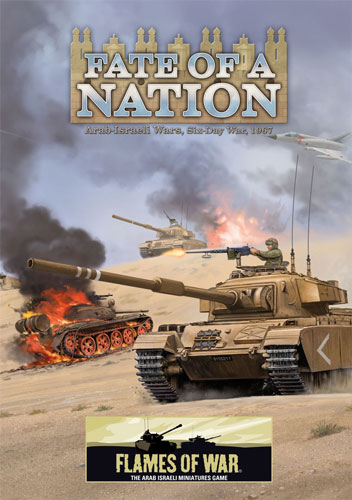
|
The Tanks Of '67
with Dr. Michael L. McSwiney
In the 1967 Six-Day War, Israel pitted its roughly 800 tanks against the nearly 2500 tanks of the surrounding Arab nations. While both sides fielded modern designs like the British Centurion, the American M48 Patton, and the Soviet T-55, these were expensive. Older designs dating back to the Second World War made up the numbers.
M4 Sherman
The M4 Sherman tank was developed in 1941 in anticipation of America’s involvement in the Second World War, and went on to become the standard tank of the western Allied forces. The Sherman underwent many evolutionary changes during the war, and by the end of it nearly 50,000 had been produced. The later versions of the Sherman tank fought on through the Korean War in the early 1950s, but the Sherman was phased out of American service soon thereafter.
|
Fate Of A Nation
The fate of a nation hangs in the balance. Israel cannot lose even a
single battle. One defeat would mean the destruction of the tiny Jewish
state. Not waiting to be attacked by the Arab forces massing on its
borders, Israel strikes first.
Learn more about Fate Of A Nation here... |
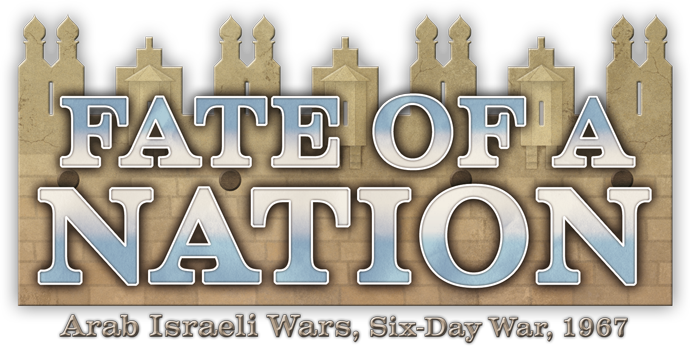 |
Israel acquired its first Sherman tank via a clandestine arrangement with British soldiers tasked with destroying military equipment prior to the British withdrawal from Palestine in 1948. By 1956, they had several hundred Sherman tanks scrounged from various scrap yards around the world, including 60 M1 Shermans provided by France (M1 was the Israeli designation for the M4A1 tanks armed with 76mm guns). The Israelis acquired more M1 tanks in the late 1950s, having some 300 at their peak. By 1967 the remaining M1 tanks had been fitted with the improved HVSS suspension of the ‘Easy Eight’ and were used for infantry support work on the Jordanian front.
|
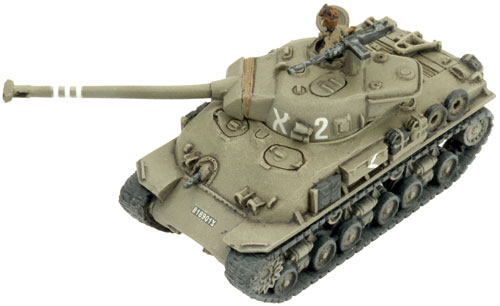
|
Up-gunned Shermans
With the surrounding Arab nations receiving increasingly powerful Soviet tanks, the Israelis began to modify their Sherman tanks to keep pace. The first model, the M50 Sherman, mounted the French 75mm CN-75-50 gun from the AMX-13 light tank in a modified 75mm turret. The first 50 vehicles were ready just in time for the 1956 war.
Right: The Israeli M50 Sherman.
|
| The mobility of these initial vehicles was poor
and the engine was overworked, so the engines were replaced with
powerful Cummings diesel engines and the suspension upgraded to HVSS
like the M1 Super Shermans. In 1967 the Israelis had 179 M50 ‘French’
Sherman tanks. |
First shown publicly in 1965, the M51 Isherman (a name used by the crews from a contraction of ‘Israeli Sherman’) was an even more radical adaptation of the venerable Sherman design. Based on the 76mm-armed M1 chassis, the M51 was armed with a modified French 105mm gun from the latest AMX-30 main battle tank. The
gun itself had been shortened and a huge muzzle brake was added to
handle its recoil.
Left: The Israeli M51 Isherman.
|
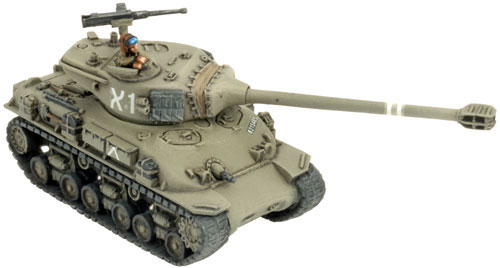
|
Because of these changes and the cramped nature of
the Sherman turret, it also used modified ammunition with a shorter
cartridge. Using HEAT (High Explosive Anti-tank) rounds, the M51 proved a
deadly fighting machine capable of defeating opponents armed with far
more modern Soviet designs such as the T-54, T-55, and even the T-62
when it faced them in 1973. Total production of the M51 was roughly 180
vehicles.
Palestinian Shermans
The Egyptians used Sherman tanks in the 1956 war, but by 1967 they were nearing the end of their effective service life. The remaining 30 were handed over to the 20th Palestinian Division in the Gaza Strip, forming their one and only tank battalion. As with the Israelis, the Egyptians had recognised the limitations of the Sherman’s short-barrelled 75mm gun and gone to the French for a solution. They settled on the same gun as the Israeli M50, but rather than modifying the turret, simply replaced it with the turret from an AMX-13 light tank to create the M4/FL-10. A handful of these served in the Palestinian tank battalion.
|
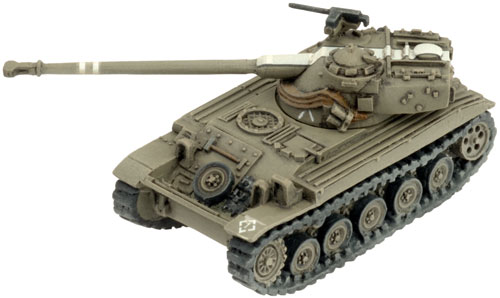
|
AMX
In an effort to minimise future conflicts in the Middle East, the major powers set up an arms embargo after the 1948 war. However, when the Suez Crisis came to a head, France hastily equipped their new ally, Israel, with up-gunned Sherman tanks and brand-new AMX-13 light tanks.
Right: The Israeli AMX.
|
The AMX-13 is smaller than a WWII Stuart light
tank, with the same speed and armour, but mounts a gun as powerful as
that of the Panther tank. They achieved this feat with a radical
oscillating-turret design. The gun was fixed to the top half of the
turret allowing a twelve-round autoloader to feed directly into the rear
of the gun. The whole top half of the turret rocked back and forward on
the bottom half elevating and depressing the whole weapon system.
While this removed a crew member and made the
turret extremely small, it did have drawbacks. The autoloader was slower
than a human loader, and once the twelve ready rounds were used, the
tank had to retire out of range while the crew spent 15 minutes or more
out of the tank reloading it. Combined with its light protection, this
led to the AMX being relegated to reconnaissance roles in the 1967 war. |
Centurion
The Centurion was designed during World War II to provide the British Army with a universal tank capable of withstanding hits from German 8.8cm anti-tank weapons. The first mock-up was completed in May 1944, but only a few prototypes were completed before the end of hostilities. Powered by a Rolls-Royce Meteor engine mated with the new Horstmann suspension, the Centurion was slow, but had excellent cross-country performance.
Left: An Israeli Centurion. |
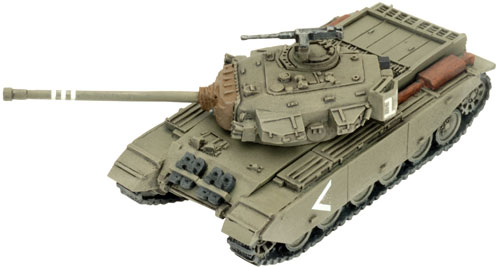
|
Initially armed with the magnificent 17 pounder gun, in 1948 the
Centurion Mk III was upgunned to the 20 pounder to enable it to tackle
newer Soviet tanks. With a strong combination of armour, firepower, and
mobility, the Centurion was the first main battle tank of the post-war
era.
Egypt and Jordan both received British Centurions, but supplies ceased
when the Suez Crisis alienated them from Britain. The Egyptians did not
use the handful they received, but the Jordanian Arab Army still had a
battalion of about 44 Centurions fighting around Jerusalem in 1967. |
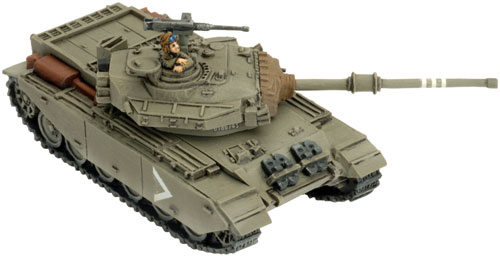
|
Sho’t - Scourge
Israel attempted to acquire Centurion tanks for several years from Britain, but was rebuffed until after the Suez Crisis of 1956. In 1959 a clandestine army delegation was sent to Britain to begin training and familiarization with the Centurion tank. As the agreement was secret, the code name Sho’t (Scourge or Whip) was used to refer to the Centurion in Israeli service.
Right: An Israeli Sho't. |
Israel initially received roughly 20 used Mark 5
tanks, but later began to purchase new Mark 8 tanks. By the time of the
1967 conflict, Israel had nearly 300 Centurions in service. All but 12
used around Jerusalem had been upgraded with the new British 105mm L7
gun.
The Centurion originally had a poor reputation
with the Israeli Defence Force, being thought unreliable and inaccurate.
This turned out to be a result of the Israeli’s extremely ‘rough and
ready’ approach to maintenance and gun calibration. After an
embarrassing incident during the Water War in which they failed to hit
anything in a day-long engagement with the Syrians, the Armoured Force
dramatically improved their maintenance and gunnery practices. After
that the Centurion became the preferred tank for its accurate gun and
resilience when hit.
After the Six-Day War of 1967, the Israelis
further upgraded their Sho’t Centurions by replacing the Meteor petrol
engine with an American Continental diesel engine, giving it more speed
and a longer range.
M48 Patton
Another Western tank
used in quantity by both sides in the Six-Day War was the American M48
Patton. Although descended from the M26 Pershing of WWII, the M48 was an
almost totally new design. The M41 90mm gun was longer and
significantly more powerful than the old WWII gun, while the engine
generated 60% more power, more than compensating for the extra weight of
its thicker armour. The resulting tank was the equal of any main battle
tank in the world, despite a reputation for flammability when hit.
|
Magach - Battering Ram
In its on-going quest for more and better tanks, Israel managed to acquire more than a hundred M48A1 and M48A2C tanks from West Germany and the United States. These were codenamed Magach (Battering Ram).
Left: An Israeli Magach 2.
|
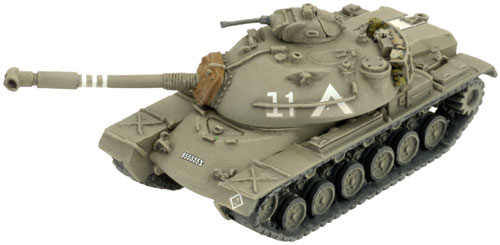
|
The Centurion’s suspension was thought more suitable for the rocky
ground in central and northern Israel, so the Magach was assigned to
Southern Command for operations in the Sinai Desert where its greater
speed and range proved useful.
Having upgraded their Centurions with 105mm L7 guns, the Israelis started experimenting with upgunning their Magach 2 tanks as well. By the time of the Six-Day War, they had a company of Magach 3 fitted with the 105mm gun and ready for combat. These were found to be far more effective than the older 90mm guns against the Arabs’ heavily-armoured T-55 and IS-3 tanks.
Jordanian M48 Tanks
By threatening to turn to the Soviet Union like the other Arab armies, Jordan managed to purchase six battalions of M47 and early model M48 Patton tanks from the United States. These formed the bulk of their armoured strength, and proved a serious obstacle for the Israeli forces in the West Bank who were largely equipped with various types of Sherman tanks.
|
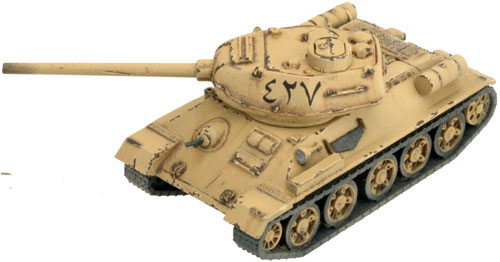
|
T-34/85
Egypt, as a former British protectorate, received military assistance and equipment from Great Britain after World War II. However, following the 1952 revolution, the United Arab Republic (as Egypt became) pursued an anti-colonial policy which received enthusiastic support from the Soviet Union, including substantial quantities of military hardware.
Right: An United Arab Republic T-34/85. |
By 1967, the United Arab Republic and Syrian
inventories of armour were predominantly of Soviet origin. Initially,
the most numerous tank was the T-34/85, one of the most common tanks in
the world in the post-war era. Stocks came from Czechoslovakia which
produced them until the late 1950s.
Retaining the robust mobility and sloped armour of the original T-34, with the added punch of a long 85mm gun, the T-34/85 was an capable vehicle and pointed the way to the main battle tank concept. Its overall performance was roughly equivalent to a 76mm-armed M1 Super Sherman, many of which were used by the Israelis.
By
the time of the 1967 war, the T-34/85 had been relegated to supporting
the infantry divisions, but was still quite capable against lighter
Israeli tanks, especially when supported by heavy tanks and tank destroyers. |
SU-100M
Based on the reliable T-34 chassis, the SU-100 was a self-propelled gun with a fixed superstructure rather than a conventional turret. It was common for the Soviet and German armies in World War II to field tank destroyers with limited-traverse weapons. Because the superstructure was generally lighter and subject to fewer
restrictions than a conventional turret, a larger gun could be carried
on the same chassis. In the case of the SU-100, the potent 100mm D-10S
gun was used.
Left: United Arab Republic SU-100Ms on the move. |
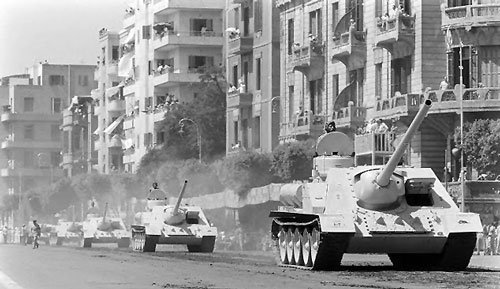
|
Although it was slow firing due to its extraordinarily
large and heavy rounds (the gun was originally designed for use on
ships), it was accurate and able to penetrate most tanks at long range.
The United Arab Republic fielded the SU-100M, a Czech variant on the
SU-100, with considerable success in the 1956, 1967, and 1973 wars. Most
divisions had a battalion of 16 to 22 SU-100M tank destroyers to back
up their medium tanks. |
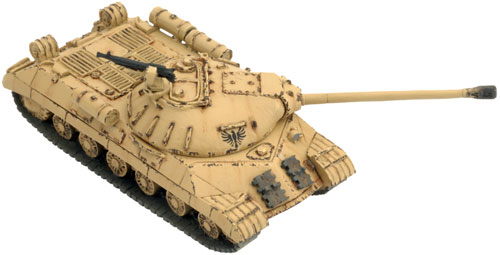
|
IS-3
Unlike the Western nations, the Soviet Union continued with heavy tank development long after WWII. First seen by Western nations at the 1945 Victory Parade in Berlin, the IS-3 was an evolutionary development of the Iosif Stalin series of heavy tanks used extensively during WWII.
Right: An United Arab Republic IS-3. |
The IS-3 heavy tank made excellent use of sloped
armour on the hull and had a hemispherical turret which would be seen on
nearly all post-war Soviet tanks. Armed with the outstanding D-25T
122mm gun, the IS-3 was, however, relatively slow and suffered from
reliability issues, especially in the hot desert. Egypt acquired roughly
100 of these tanks, assigning them to support the T-34/85 tanks in the
infantry divisions and back up the T-55 tanks in the mechanised and
armoured divisions. Their combat results during the Six-Day War were not
auspicious. Designed for attacks on heavily fortified positions, they
were not as
effective in fast-moving tank battles.
While the 90mm-armed Israeli M48 tanks had great
difficulty penetrating the frontal armour of the IS-3 at normal combat
ranges, the slow rate of fire of the IS-3, poor fire control, and poor
mechanical reliability proved to be significant handicaps in knocking
them out in return. |
T-54 and T-55
Originally designed as an evolutionary replacement for
the T-34 medium tank, the T-54 (and the later T-55) quickly evolved into
the Soviet Union’s first main battle tank. Entering full production in
1947, the T-54 and T-55 series became the most produced tank in history
with up to 100,000 units eventually rolling off the assembly lines over
the next 35 years.
Left: An United Arab Republic T-54 / T-55.
|
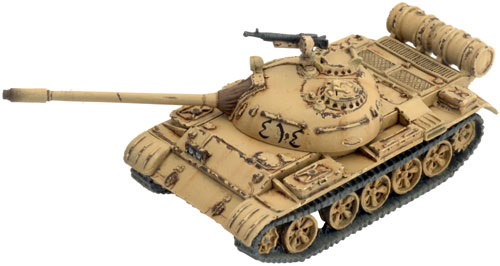
|
The hallmarks of the design were its mechanical
simplicity, good mobility, compact design, and the potent D-10T 100mm
gun (the same weapon as used in the SU-100M). Unfortunately the compact
design resulted in a cramped interior which interfered with the
effective operation of the tank and its armament.
The T-54 and T-55 were liberally provided to Soviet allies and satellite
states including the United Arab Republic and Syria. The Sinai Field
Army had several hundred T-54 and T-55 tanks grouped in the 4th Armoured
Division and the 6th Mechanised Division.
Despite many of them being fitted with infrared equipment and stabilisers, they generally fared poorly
against
the better utilised Israeli armour. Their poor gunnery and abysmal
tactics allowed the well-trained Israelis to turn back the Arab attacks,
even at night.
|
The Aftermath
By the end of the Six-Day War, Israel’s effective area had increased threefold through the addition of the Gaza Strip, the Sinai Peninsula, the West Bank, and the Golan Heights. The Arab nations had lost hundreds of tanks whereas Israeli losses had been comparatively light. Israel had captured vast stocks of Arab armour including Centurions, M47 and M48 Pattons, IS-3 heavy tanks, and T-54 and T-55 medium tanks. Many of these vehicles were pressed into Israeli service and saw action a few years later during the 1973 Yom Kippur War. Israel’s success in the Six-Day War, however, was not due to overwhelming technical superiority, but rather to superior tactics and their ability to achieve near complete air-superiority at the outset of the conflict.
~ Dr. M.L. McSwiney |
Last Updated On Wednesday, December 3, 2014 by Blake at Battlefront
|
|